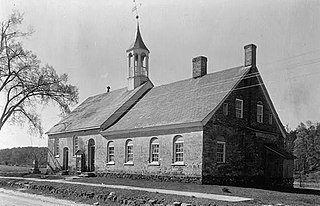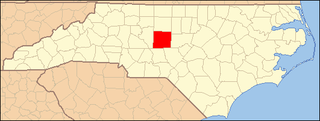Related Research Articles

Bethania is the oldest municipality in Forsyth County, North Carolina, United States, and was most recently incorporated in 1995, upon the reactivation of the original 1838/1839 town charter. In 2009, Bethania celebrated the 250th anniversary of its establishment in 1759. As of the 2020 census, the town population was 341.

Asheboro is a city in and the county seat of Randolph County, North Carolina, United States. The population was 25,012 at the 2010 census. It is part of the Greensboro–High Point Metropolitan Area of the Piedmont Triad and is home of the state-owned North Carolina Zoo.

Randleman is a city in Randolph County, North Carolina, United States. The population was 4,113 at the 2010 census. It is the home of NASCAR's Petty family, the Victory Junction Gang Camp and was the location of the Richard Petty Museum from 2003 to 2014.

Seagrove is a town in Randolph County, North Carolina, United States. The population was 285 at the 2019 census. It was named after a railroad official when the area was connected by rail. The center of population of North Carolina is located a few miles east of Seagrove.

Old Salem is a historic district of Winston-Salem, North Carolina, United States, which was originally settled by the Moravian community in 1766. It features a living-history museum which interprets the restored Moravian community. The non-profit organization began its work in 1950, although some private residents had restored buildings earlier. As the Old Salem Historic District, it was declared a National Historic Landmark (NHL) in 1966, and expanded in 2016. The district showcases the culture of the Moravian settlement in North Carolina during the 18th and 19th centuries, communal buildings, churches, houses and shops.

Fonthill, also known as Fonthill Castle, was the home of the American archeologist and tile maker Henry Chapman Mercer, in Doylestown, Pennsylvania.

The Moravian Pottery & Tile Works (MPTW) is a history museum which is located in Doylestown, Pennsylvania. It is owned by the County of Bucks, and operated by TileWorks of Bucks County, a 501c3 non-profit organization.

The Charles Pinckney National Historic Site is a unit of the United States National Park Service, preserving a portion of Charles Pinckney's Snee Farm plantation and country retreat. The site is located at 1254 Long Point Road, Mount Pleasant, South Carolina. Pinckney (1757-1824) was a member of a prominent political family in South Carolina. He fought in the American Revolutionary War, was held for a period as prisoner in the North, and returned to the state in 1783. Pinckney, a Founding Father of the United States, served as a delegate to the constitutional convention where he contributed to drafting the United States Constitution.

This is a list of structures, sites, districts, and objects on the National Register of Historic Places in North Carolina:

North Carolina Highway 705 (NC 705) is a primary state highway in the U.S. state of North Carolina. The route is marked as the Pottery Highway or Pottery Road and as a North Carolina Scenic Byway due to the large number of potters in and surrounding Seagrove.

Town Creek Indian Mound is a prehistoric Native American archaeological site located near present-day Mount Gilead, Montgomery County, North Carolina, in the United States. The site, whose main features are a platform mound with a surrounding village and wooden defensive palisade, was built by the Pee Dee, a South Appalachian Mississippian culture people that developed in the region as early as 980 CE. They thrived in the Pee Dee River region of North and South Carolina during the Pre-Columbian era. The Town Creek site was an important ceremonial site occupied from about 1150—1400 CE. It was abandoned for unknown reasons. It is the only ceremonial mound and village center of the Pee Dee located within North Carolina.

Bethabara Historic District encompasses the surviving buildings and archaeological remains of a small Moravian community, that was first settled in 1753. Located in present-day Forsyth County, North Carolina, it is now a public park of the city of Winston-Salem. It was designated National Historic Landmark in 1999.

Whynot is an unincorporated community in Randolph County, North Carolina, United States, and is included in the Piedmont Triad metropolitan region. Whynot is located on NC 705, also known as the "North Carolina Pottery Highway", one mile (1.6 km) southeast of Seagrove and seven miles (11 km) west of Jugtown Pottery, a historic pottery listed on the National Register of Historic Places. The North Carolina Pottery Highway contains over 100 potteries and galleries in a 15-square-mile (39 km2) region surrounding Seagrove.

This list includes properties and districts listed on the National Register of Historic Places in Randolph County, North Carolina. Click the "Map of all coordinates" link to the right to view a Google map of all properties and districts with latitude and longitude coordinates in the table below.

Fonthill, Mercer Museum and Moravian Pottery and Tile Works is a National Historic Landmark District located at Doylestown, Bucks County, Pennsylvania. It consists of three properties built by Henry Chapman Mercer (1856-1930) in a distinctive application of the principles of the Arts and Crafts movement, which are also notable for the early use of poured concrete: Fonthill, the Mercer Museum, and the Moravian Pottery and Tile Works. All three are now museum properties of the Bucks County Historical Society. The landmark designation for the group was made in 1985; each property is also individually listed on the National Register of Historic Places.
Green's Shell Enclosure is a historic archeological site located at Hilton Head Island, Beaufort County, South Carolina. The site includes one of 20 or more prehistoric Indian shell middens in a ring shape located from the central coast of South Carolina to the central coast of Georgia. They are believed to date early in the second millennium BC, and they contain some of the earliest pottery known in North America.
William Dennis Pottery Kiln and House Site is a historic archaeological site located at Randleman, Randolph County, North Carolina. It was the site of the pottery kiln and home of William Dennis and his son Thomas and remained in operation until 1832. The pottery produced simple, utilitarian redware, and a variety of decorative slipware and tableware products. The William Dennis pottery and house site was located in 1974.
The Thayer Farm Site, designated by the Smithsonian trinomial 31RD10, is a prehistoric archaeological site in Randolph County, North Carolina. The site, long known to local collectors for surface level finds, was formally investigated in 1984, and was found to consist of a stratified series of deposits bearing evidence of occupation between about 1200 and 1700 AD. Finds at the site include pottery fragments, projectile points, animal bone, shell fragments, and human bone, the latter indicating the presence of burials. Two acres of the site were donated to the Historic Preservation Foundation for North Carolina in 1985.
The Moravian Historical Society in Nazareth, Pennsylvania, was founded in 1857. Its mission is to preserve, interpret, and celebrate the rich culture of the Moravians. It is the third oldest historical society in the Commonwealth of Pennsylvania. The Moravian Historical Society is housed in the 1740-1743 Whitefield House on the Ephrata Tract in downtown Nazareth. The Moravian Historical Society is affiliated with the Moravian Archives in Bethlehem, Pennsylvania, the repository for records of the Moravian Church in North America, Northern Province.
References
- 1 2 "National Register Information System". National Register of Historic Places . National Park Service. July 9, 2010.
- ↑ "Mount Shepherd Pottery Site History" (PDF). Randolph County. Retrieved September 4, 2015.